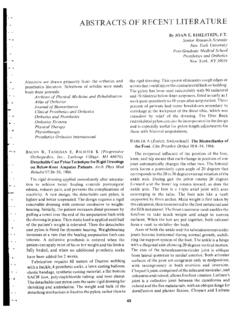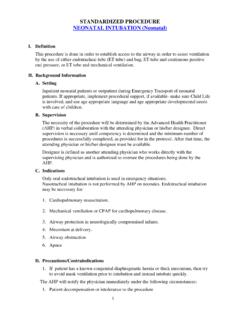Transcription of Motion Analysis and Biomechanics - Veterans Affairs
1 SECTION TWOC hapter TwoMotion Analysis and Biomechanicsby Robert W. Soutas-Little, Soutas-Little is a Professor of Theoretical Mechanics and Director of both the Biomechanics EvaluationLaboratory and Biodynamics Laboratory at Michigan State University in East Lansing, , or Newtonian, mechanics is the oldestbranch of physics devoted to the study of Motion , theforces that cause that Motion , and the internal forcesthat act within the body. Biomechanics is the applica-tion of Newtonian mechanics to the study of theneuromuscular skeletal system. Biomechanics has foundits greatest use in orthopaedics and physical medicineand rehabilitation characterizing function and dysfunc-tion of the muscular skeletal system. One branch ofbiomechanics, gait Analysis or Motion Analysis of humangait, has developed since early studies in the late Analysis has been extended during the past twodecades to investigate many other activities in additionto gait Analysis .
2 Currently, postural balance studies, stairascending, or descending, and upper limbs are all beingstudied using Motion Analysis and the techniques ofbiodynamics. Although Motion Analysis requires the useof the mathematical techniques of dynamics, the presen-tation here will be on a conceptual basis where PARAMETERS OFTHEGAITCYCLET here are variations in the definitions of thedifferent phases of the gait cycle during walking but themost commonly defined phases will be discussed gait cycle is defined as the period from heel contactof one foot (for example, the left foot) to the next heelcontact of the same foot. This cycle is broken into twoparts, stance phase and swing phase. On the average, thegait cycle is about one second in duration with 60percent in stance and 40 percent in swing. The stancephase is further divided into an initial double stance,followed by a period of single stance and then a finalperiod of double stance.
3 Double stance indicates thatboth feet are in contact with the ground; single stance isthe period when only one foot is in contact with theground. When walking, there must be a period ofdouble stance and when running, this period is replacedby a flight phase during which neither foot is in contactwith the ground. The walking gait cycle is illustrated inFigureI . During the early part of stance phase, the heelis in contact with the ground, progressing to foot-flatduring single stance and then to the forefoot contactduring the final double stance phase ending with would be the normal contact areas of the plantarsurface of the foot with the ground but may vary greatlywith pathological gait. For example, equinus gait ischaracterized by the forefoot striking the ground firstand then the contact area, progressing to the posterior insome cases while in others the heel never contacts double stance, the weight is transferredfrom one foot to the other.
4 During single stance, thecenter of mass of the body passes over the foot in4950 RRDS Gait Analysis in the Science of RehabilitationRight swing Left swingSwing PhaseLeft lRight10%` 40% ! 10% ! 40%Double Single Stance DoubleFigure 1 The Gait CycleFigure parameters of the gait PhaseStanceLeft - Swing StanceRightSingle StanceRight - SwingLeftpreparation for shifting to the other limb. Walking hasbeen described as a series of falls from one limb to theother and it is obvious that the greatest danger of anactual fall is during this period of transferring SEGMENTSIt is important to understand the basic assumptionsthat are made to analyze human Motion using thetechniques of rigid body dynamics. The most basicassumption is that body segments can be modeled asrigid bodies, that is, the position and Motion of theunderlying skeleton can be approximated by trackingthe position and Motion of the surface tissue.
5 The errorthat arises is referred to as soft tissue Motion error,which is inherent in all Motion Analysis of humansubjects. Only a few research tests have been performedto test the amount of error due to soft tissue movementand these tests have involved invasive techniques ofputting pins in the bones and attaching markers to thosepins and comparing pin marker movement with that ofsurface markers (1). Therefore, it is important to placesurface markers at points where soft tissue movement isa minimum. Obviously, this can present problems whentesting individuals who are a body is modeled as a rigid body, thedistance between any two points on that body isconstant. Consider a body segment such as the thighmodeled as a single rigid body, as shown markers are shown on the body segment so thatthey are non-collinear, that is, they do not lie on a markers form a triangle on the body segment and itis assumed that the lines AB, BC, and CA do not51 Chapter Two: Motion Analysis : Biomechanicschange in length.
6 The position of each marker ismeasured by a Motion Analysis system and this positionis expressed as coordinates in a fixed laboratoryreference system. Different systems use different orien-tation of the laboratory coordinate systems but themethod of Analysis is the same for all systems. Considerthe laboratory system shown inFigure3 and theposition vectors to the three segment markers. We willdefine the three position vectors as:rA = XA (t)I+YY (t)J+ZB (t)KrB = X B (t)I+YB (t)J+ZB (t)K [1]r c = X c(t)I+Yc(t)J+Zc(t)Kwhere 1, J, K are the unit base vectors in the laboratorycoordinate system, that is, they are vectors of magnitudeone that serve as pointers in theX, Y,and Z directions,respectively. Note that the components of each positionvector are the coordinates of the marker position and areshown as a function of time as the marker position willchange as the marker moves.
7 This position is measuredat specified intervals in time and this interval is dictatedby the camera speed. The camera speed is usuallyspecified in Hz (Hertz) or pictures per second. There-fore, a 100 Hz system would take 100 pictures persecond or at intervals of 10 ms. As previously stated,the vector multiplying each component of the positionvectors is the unit base vector of the laboratory systemand may be thought of as a pointer of magnitude onepointing in the coordinate direction. These unit vectorsform the basis of all vector Analysis and are fundamen-tal to the understanding of biodynamics. The laboratorycoordinate system is a right-handed coordinate system,that is, the X axis is aligned with the thumb of the righthand, the Y axis is aligned with the index finger of theright hand and the Z axis is aligned with the middlefinger of the right hand. All coordinate systems used invector Analysis must be right-handed coordinate systems(SeeFigure 4).
8 The position vectors to the three markers on thebody segment will be used to obtain a segmentalcoordinate system, which may be thought of as threemutually perpendicular lines, attached to the bodysegment, that remain at a fixed orientation to thatsegment. In the discussion that follows, we will assumethat the x segmental axis is in the anterior direction, they segmental axis is in the medial-lateral directiondirected to the left of the body segment, and the zsegmental axis is directed in a superior direction on thebody segment or directed distal to proximal in a defining a rigid body vectors to body segment segment. Although there are many different waysto form the segmental coordinate system, we willassume for this discussion that the three markers havebeen placed on the body segment such that two markersdefine a segmental axis and the three markers form asegmental anatomical plane.
9 For example, on the thigh,markers A and C may define the superior axis of thethigh and the three markers are placed in a parasagittalplane of the thigh. A relative position vector from C toA is designated by rA,c (A relative to C) and is obtained52 RRDS Gait Analysis in the Science of RehabilitationFigure hand coordinate subtracting the coordinates of marker C from thoseof marker r A rc [2]It is important to realize that the length of this relativeposition vector does not change, since we have assumedthat the body segment is rigid. The relative positionvector may be thought of as a pencil glued to the bodysegment that is oriented with the body segment but doesnot change in length. If the length is computed on aframe-by-frame basis, the validity of the assumptionmay be measured. This length is called the magnitude ofthe relative position vector. A unit vector in thesegmental coordinate direction z is obtained by dividingthe relative position vector by its A/ck=.
10 [3]This unit vector will change its orientation in space butnot its orientation relative to the body segment. A vectoroperation called the vector product, or cross product, isdefined such that the resulting vector is perpendicular tothe plane formed by two vectors. Let us form a secondrelative position vector from C to Brime =r B rc [4]If A, B, and C form a parasagittal plane, then a vectorperpendicular to this plane in the medial-lateral direc-tion can be obtained by taking the cross productbetween the relative position vectors defined in Equa-tions 2 and 4 yielding a unit vector in the y segmentalcoordinate final coordinate direction for the body segment isobtained by the cross product of the two segmentalcoordinate base jxk [6]The position of the body segment can now be deter-mined by the position vector to marker C and thethree-dimensional (3-D) orientation of the body segmentis defined by the triad of segmental base unit vectors asshown inFigure 5.










